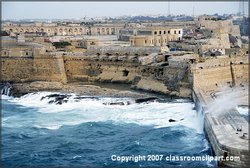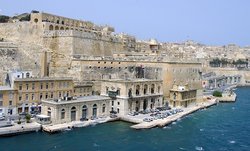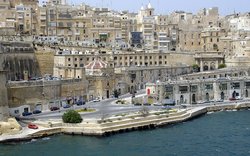Malta
|
|
| |||||
| Missing image LocationMalta.png Location of Malta | |||||
| Official languages | Maltese and English | ||||
| Capital | Valletta | ||||
| Largest City | Birkirkara | ||||
| President | Edward (Eddie) Fenech Adami | ||||
| Prime Minister | Lawrence Gonzi | ||||
| Religion | Catholicism | ||||
| Area - Total - % water | Ranked 184th 316 km? Negligible | ||||
| Population - Total (2003) - Density | Ranked 211th 399,867 1262/km² | ||||
| Independence - Date | From the UK September 21, 1964 | ||||
| Currency | Maltese Lira | ||||
| Time zone - in summer | CET (UTC+1) CEST (UTC+2) | ||||
| National anthem | L-Innu Malti | ||||
| Internet TLD | .mt | ||||
| Calling Code | 356 | ||||
| Patron Saints | St. Paul St. Agatha Pope Pius V | ||||
The Republic of Malta is a small and densely populated island nation in southern Europe. It consists of an archipelago in the Mediterranean Sea directly south of Italy. These strategically located islands have been ruled and fought over by various powers over the centuries.
| Contents |
History
- Main article: History of Malta
Malta has been inhabited since around 5200 BC and a significant prehistoric civilization existed on the islands, a civilization which predated the Pyramids of Giza by a millennium, prior to the arrival of the Phoenicians who heavily colonized the island and used it as an outpost from which they expanded their sea explorations and trade in the mediterranean. The name of the main island is thought to have originated from the Phoenician word "Malat", meaning safe haven. These islands later came under the control of Carthage (400 BC) first and then of Rome. The islands prospered under Roman rule, during which time it was considered as a Municipium and as a Feodorata Civitas, and many Roman remains still exist, testifying to the close link between the Maltese inhabitants and the people of Rome. In AD 60, the islands were visited by Saint Paul, who is said to have been shipwrecked on the shores of the aptly named Saint Paul's Bay. After a short spell of Byzantine-rule, and a probable sack by the Vandals, the islands were conquered by the Arabs in AD 870; their influence can be seen most prominently in the modern Maltese language, which appears to have stemmed from an Arabic dialect, though it has been heavily influenced by Romance tongues. The Maltese written language uses the standard Latin alphabet. The period of Arab rule lasted until 1090, when the island was taken by the Sicilian Normans, restoring Christianity again. Subsequent rulers included the Anjouvines, Hohenstaufen and the Aragonese. The Maltese nobility was established during this period; some of it dates back to 1090. 32 noble titles remain in use today, of which the oldest is Barons of Djar il Bniet and Buqana.
In 1530 the islands were given by Spain to the Order of Knights of the Hospital of St. John of Jerusalem in perpetual lease (Aragon having owned the island as part of their Mediterranean empire for some time). These Knights, a militant monastic order now known as the "Knights of Malta", had been driven out of Rhodes by the Ottoman Empire in 1522. They withstood a fully-blown siege by the Ottoman Turks in 1565, who, at that time, were considered to be the greatest non-European military power: after this they decided to increase the fortifications, particularly in the Inner-harbour region, where the new city of Valletta, named after Jean Parisot de Vallette, was built.
Their reign ended when Napoleon conquered the islands in 1798. The occupying French forces were unpopular, however, due particularly to their negative attitude towards religion; the Maltese therefore rebelled against them, and the French were forced behind the fortifications. Great Britain, along with the Kingdom of the Two Sicilies, sent munitions and aid; Britain also sent part of her navy, which instigated a blockade of the islands. The isolated French forces, under General Claude-Henri Belgrand de Vaubois, surrendered in 1800, and the island became a British protectorate, being presented by several Maltese leaders to Sir Alexander Ball -- a move that was unpopular among the islanders.
In 1814, as part of the Treaty of Paris, Malta officially became a part of the British Empire and was used as a shipping waystation and fleet headquarters. Malta's proximity to the Suez Canal proved to be its main asset during these years, and it was considered to be a most important outwork to the British dominions in India. In the 1930s, due to Malta's cultural and geographical proximity to Italy, the British Mediterranean Fleet was moved to Alexandria. Malta played an important role during World War II, owing to its vicinity to Axis shipping lanes, and its people's bravery led to the awarding of the George Cross now seen on its flag.
After the war, and after a short spell of political instability due to the Malta Labour Party's unsuccesful attempt at 'Integration with Britain', Maltese was granted independence on September 21, 1964. Under its 1964 constitution, Malta initially retained Queen Elizabeth II as sovereign of Malta, with a Governor-General exercising executive authority on her behalf, but on December 13, 1974 it became a republic within the Commonwealth, with the President as head of state. Although Malta had been independent since 1964, the British armed forces did not finally leave until March 31, 1979, when the Maltese Prime Minister of the time, Dom Mintoff, demanded they either pay a greater rent for their bases, or withdraw. This freed Malta of foreign military occupation for the first time in history, an event celebrated as Freedom Day. Malta joined the European Union on May 1, 2004 after months of heavy campaigning in its traditionally heated political scene.
Politics
Main article: Politics of Malta
The President of the Republic is elected by the Maltese parliament, who appoints as Prime Minister the leader of the party with a majority of seats in the unicameral House of Representatives, known in Maltese as Kamra tar-Rappreżentanti. Before amendments to the Constitution, the government was elected from the party obtaining the majority of seats. This system led to gerrymandering and it can be said that it led the country to an escalating spiral of civil strife, which peaked in 1981 – Due to these problems, the Constitution was changed giving the victory to the party with the largest number of votes, which means that extra seats are given to the party that posses the largest amount of votes but has less seats than its contender.
The president also nominally appoints, upon recommendation of the prime minister, the individual ministers to head each of the government departments. This cabinet is selected from among the members of the House of Representatives. This body consists of between 65 and 69 members elected on the basis of proportional representation. Elections must be held at least every 5 years. Candidates for any vacancies are determined by the majority of votes obtained by a candidate during the previous elections.
The main political parties are the Nationalist Party and the Labour Party. The Nationalist Party embraces a Christian Democrat ideology, and the Labour Party a Socialist ideology. There is also the green party, known as Alternattiva Demokratika. The Nationalist party is currently at the helm of the government, the Prime Minister being Dr. Lawrence Gonzi. Labour Party, under Dr. Alfred Sant is in opposition. There are also several minor parties, such as the 'Alpha Party' and the rightwing 'Imperium Europa', led by the controversial Norman Lowell.
While not officially a political party, the Maltese branch of the Roman Catholic Church commands great influence over the main political parties on a number of issues, prominently divorce, which the Maltese Curia vehemently opposes. The pronounced lobbying carried out by the Maltese Curia effectively derails any attempt for a national consultation on the legalisation of divorce or any other issue on the Curia's agenda.
Geography
Mt-map.png
Map of Malta
Main article: Geography of Malta
Malta comprises an archipelago in the central Mediterranean Sea, some 93 km south of Sicily. Only the three largest islands Malta Island (Malta), Gozo (Għawdex), and Comino (Kemmuna) are inhabited. Numerous bays along the indented coastline of the islands provide good harbours, whereas the landscape of the densely populated islands themselves is characterised by low hills with terraced fields. The highest point is the Ta'Dmejrek on Malta Island at 253 m, located near Dingli, but the highest point is not easy to locate, and many locals have no idea where it is.
The local climate is a Mediterranean temperate climate, with mild, rainy winters and hot, dry summers. Effectively there are only two seasons, which makes the islands attractive for tourists especially during the drier months.
Economic History
Until 1800, Malta had very few industries except the cotton, tobacco, and shipyards industry. The dockyard was later used by the British for military purposies. At times of war, Malta's economy prospored due to its strategic location.
During the Napoleonic Wars (1800-1815) Malta's economy prospoered and due to its strategic imporance the island became the focal point of a trading system. In 1808, two thirds of cargoes consigned from Malta went to Levant and Egypt, and later on one half of the cargoes to Triese. Cargoes consisted of British and colonial manufactured goods. Malta's economy had become to prosper. Many artisans such as weavers found new jobs in the port industry.
In 1820 during the Battle of Navarino which took place in Greece, the British fleet was based in Malta. In 1839, Pacific and Orient and East India Companies used Malta as a calling port on their Egypt and Levant runs. This war demonstrated Malta's strategic location and shipping importance.
In 1869, the opening of the Suez Canal was for Malta's economy another boom. There was a massive increase in the shipping tonnages which entered in the port. The Maltese economy had entered in a special phase. The Mediterranan became the "world highway of trade" and a number of ships called at Malta for coal and various supplies on their way to the Indian Ocean and the Far East.
From 1871 to 1881, 8000 workers found there jobs in the Malta Drydocks and a number of banks opened in Malta. By 1882, the Maltese Islands were at the height of their prosperity.
However the boom did not last long. By the end of the centure there was an economic decline and by 1945, Malta was in a large "economic crises". This was primarily due to the invention of large ships and many ships became oil-fired and therefore there was no need to stop in the Grand Harbour of Malta to refuel. The British Government had to extend the Dockyard.
By the end of World War II Malta's strategic importance had reached a diminishing point, air, welfare and the atomic bomb had changed the importance of the military base. The British lost control of the Suez Canal and had to the withdraw from the Naval Dockyard and transfer it for commercial shipbuilding and ship repair.
Economy (Today)
Main article: Economy of Malta
Malta’s major resources are limestone, a favourable geographic location, and a productive labour force. Malta produces only about 20% of its food needs, has limited freshwater supplies, and has no domestic energy sources. The economy is dependent on foreign trade (serving as a freight transshipment point), manufacturing (especially electronics and textiles), and tourism.
Malta has recently privatised some state-controlled firms and liberalised markets in order to prepare for membership in the European Union, which it joined on May 1 2004. Malta and Tunisia are currently discussing the commercial exploitation of the continental shelf between their countries, particularly for oil exploration.
Tourism
Malta has hundreds of museums, shops, beaches and leisure activities in a densely packed area. It is a well-known popular vacation destination. If you are visiting Malta, a useful site is www.chikarma.com
Demographics
Main article: Demographics of Malta
Malta is one of the most densely populated countries in the world, with about 1,250 inhabitants per square kilometre. The population is mostly composed of the descendants of Italian, French, Spanish and British peoples. Most of the foreign community in Malta consists of British nationals, a group centered around Sliema and the surrounding suburbs.
Roman Catholicism is established by law as the official religion of Malta; however, full liberty of conscience and freedom of worship is guaranteed, and a number of faiths have places of worship on the island. An estimated 90% of the population are Roman Catholic, though only 60% practice the religion. Malta has two official languages: Maltese and English, but Italian is also widely understood, mainly due to Italian media reaching Malta.
The population takes a high interest in politics, and is characterised by political rivalry.
Malta follows an education system similar to the UK.
Culture
Main article: Culture of Malta
Miscellaneous topics
- Communications in Malta
- Transportation in Malta
- Military of Malta
- Foreign relations of Malta
- List of cities in Malta
- Coat of Arms of Malta
- Flag of Malta
External links
- Gov.mt (http://www.gov.mt) Maltese Government Official Site
- ChooseMalta.com (http://www.choosemalta.com) An online travel and business portal, updated daily with content, factsheet, webcam, images & more
- Times Of Malta (http://www.timesofmalta.com) English Daily News
- MaltaMedia (http://www.maltamedia.com) Daily News in Maltese and English
- Di-Ve.com (http://www.di-ve.com) News / Entertainment Portal
- Maltese Business Directory (http://planetsoftpages.com) Large listing of Malta related Companies
- Chikarma (http://www.chikarma.com) – Chikarma is an indepth guide to Malta & Gozo
- About Malta (http://www.aboutmalta.com) – aboutmalta.com is an online guide to everything Maltese
- www.maltalinks.com – Malta’s Online Search Engine and Business Exchange
- Maltaseek (http://www.maltaseek.com) – Maltaseek.com is a Search Engine and Directory dedicated to Malta, Gozo and Comino
- maltafootball.com (http://www.maltafootball.com/) – a guide to football in Malta and Gozo
- Malta Military (http://www.maltamilitary.cjb.net) – A Website on the Military History of Malta
- www.filfla.com – Guide to the Maltese Islands, updated daily.
- www.maltanetworkresources.com – Search engine, directory and portal dedicated to Malta, USENET archives for Maltese newsgroups
- Malta Genealogy (http://www.maltagenealogy.com) – a site on Maltese genealogy
- Maltese Welfare (http://www.maltesewelfare.com) – a site of Welfare relating to the Maltese
- Maltese Nobility (http://www.maltesenobility.org) – a site of History and related aspects to the Nobility.
- Maltese Classifieds il-monti.com (http://www.il-monti.com) – a site of classified adverts very popular with the Maltese and Maltese living abroad. Il-monti in Maltese means flea market.
- Malta Tourist Guide (http://www.malta.biz)
- www.searchmalta.com – Malta's Number One Search Engine..
- www.buettni-malta.com – a privately run website with information about Malta and some special events.
| Countries in Europe |
|---|
| Albania | Andorra | Austria | Azerbaijan1 | Belarus | Belgium | Bosnia and Herzegovina | Bulgaria | Croatia | Cyprus2 | Czech Republic | Denmark | Estonia | Finland | France | Germany | Greece | Hungary | Iceland | Ireland | Italy | Latvia | Liechtenstein | Lithuania | Luxembourg | Macedonia | Malta | Moldova | Monaco | Netherlands | Norway | Poland | Portugal | Romania | Russia1 | San Marino | Serbia and Montenegro | Slovakia | Slovenia | Spain | Sweden | Switzerland | Turkey1 | Ukraine | United Kingdom | Vatican City |
| Dependencies: Akrotiri and Dhekelia2 | Faroe Islands | Gibraltar | Guernsey | Jan Mayen | Jersey | Isle of Man | Svalbard |
| 1. Country partly in Asia. 2. Usually assigned to Asia geographically, but often considered European for cultural and historical reasons. |
| | Missing image European_flag.png Flag of the European Union |
|---|---|
|
Austria | Belgium | Cyprus | Czech Republic | Denmark | Estonia | Finland | France | Germany | Greece | Hungary | Ireland | Italy | Latvia | Lithuania | Luxembourg | Malta | Netherlands | Poland | Portugal | Slovakia | Slovenia | Spain | Sweden | United Kingdom | |





